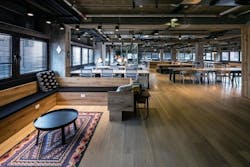For Office Redesigns, Sustainable is Fashionable
‘Green’ or sustainable buildings (also known as high performance buildings) are designed to be energy efficient and save on running costs. However, incorporating sustainable design elements into an office space can also boost productivity and overall well-being for employees.
Here are four design strategies companies use to create a work environment where people and the planet can thrive.
1. Smart Spaces
Offices have the unfortunate (and mostly deserved) reputation of being huge, cold spaces that are functional, but unwelcoming. They’re expensive to heat and cool, and they’re not laid out to match employees’ work habits (we’re looking at you, rows of generic beige pods).
Smart design favors efficient use of space while providing unique work areas for different tasks.
The Profile Rise Innovation Hub in Tel Aviv is an example of a smart space designed to encourage group brainstorm sessions, impromptu chats, formal meetings as well as quiet focus.
Long tables, comfortable couches and chairs, private boardrooms, workstation quads (and even a bar!) all provide spaces for employees to be productive and comfortable, while offering opportunities for connection, inspiration, and innovation.
2. Green Spaces
We have a natural desire to connect with nature, which scientists call biophilia. Unfortunately, our workplaces are mostly stripped of anything that resembles nature. Easy Credit, Booking.com, and Facebook are just a few companies bringing the outside inside with innovative and inspiring green designs.
If creating a living wall isn’t in your company’s budget, studies have shown that simply adding indoor plants to a space can show positive benefits; including reducing stress and sickness, and boosting productivity. Plus, they improve indoor air quality and never go out of style.
3. Bright Spaces
Maximizing an office’s use of natural light is always a bright idea. Not only does it reduce lighting costs and energy use, it can also boost employee productivity.
Chiswick Park’s London office is a shining example of using reflective wall colors and a variety of light fixtures to enhance an office’s natural lighting.
An investment in bigger windows, energy efficient lighting, and bright colors isn’t simply a design improvement. The World Green Building Council’s 2013 analysis of building design and workplace productivity found up to an 18 percent increase in employee productivity from access to daylight and openable windows.
[Report: Workers Want a Building Committed to Sustainability and Wellness]
4. Sustainable Spaces
More than ever, millennials are concerned with their employer’s environmental footprint. In fact, 76 percent of millennials consider a company’s social and environmental commitments before deciding where to work.
Making environmentally responsible design decisions, however, takes some research. For example, using wooden furniture can be damaging to forests and the ecosystem if the raw materials were not obtained responsibly.
Furniture with a FSC (Forest Stewardship Council) certification ensures the wood has been sustainably harvested. In addition, choosing products that are WELL-Certified can help your organization limit any negative impact on human health and wellbeing.
Choosing a commercial furniture company that is committed to sustainability like Global Furniture Group is another way to ensure that your office redesign is good for the planet. Global displays all of its environmental efforts directly on its website. That way, you can see exactly how the furniture you are purchasing is sourced, manufactured and distributed.
All these little things add up. By following these tips, you can rest assured that your office redesign is sustainable for both the planet and your company’s bottom line.
About the Author
Global Furniture Group offers a comprehensive portfolio of furniture solutions to meet the needs of the Workplace, Education and Healthcare markets.
